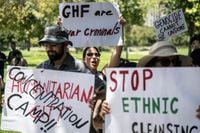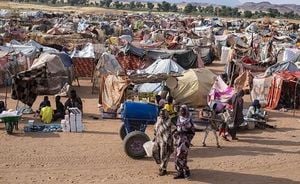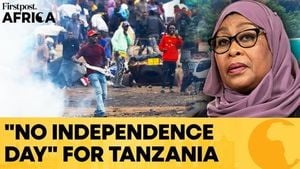On Wednesday, November 27, 2025, the Gaza Humanitarian Foundation (GHF) officially announced the permanent shutdown of its operations in the Gaza Strip, concluding a turbulent and highly controversial chapter in the region’s ongoing humanitarian crisis. The foundation, backed by both the United States and Israel, had been established in late May 2025 with the stated goal of providing an alternative to the United Nations’ established model for aid distribution. Yet, its brief existence was marred by tragedy, fierce criticism, and allegations of deepening Gaza’s suffering rather than alleviating it.
The GHF’s approach was strikingly different from traditional relief efforts. Instead of a decentralized network, the foundation concentrated aid at a handful of large, fenced, and tightly controlled distribution sites—primarily in southern and central Gaza. According to CNN, this model was promoted by both the Israeli government and certain U.S. officials as a way to prevent Hamas from intercepting or profiting from humanitarian supplies. Security at these locations was provided by private military contractors, and the operations were conducted in close coordination with the Israel Defense Forces.
However, this approach quickly proved disastrous for the civilians it was meant to help. Massive crowds of desperate Palestinians, many with no other way to access food or water, were funneled into these limited enclosures. The United Nations and human rights organizations repeatedly warned that the GHF’s model was fundamentally flawed, lacking independence and putting civilians at unacceptable risk. According to Gaza’s local authorities, between late May and October 2025, at least 2,615 Palestinians—including 225 children—were killed as a direct result of the GHF’s aid distribution mechanism. Of these, 1,506 were reportedly shot dead by Israeli soldiers while waiting near GHF sites, and 1,109 were killed inside the sites themselves, many by direct Israeli gunfire. On July 20, 2025 alone, Israeli forces killed 93 Palestinians at various GHF distribution sites, injuring dozens more.
The carnage at these distribution points was not limited to shootings. Stampedes, clashes, and chaos became routine as thousands pressed in for dwindling supplies, and the sites quickly earned the grim nickname "death traps" among Gazans. The UN refused to participate in the GHF’s operations, citing not only the model’s lack of neutrality but also the extreme safety risks it posed. UN officials asserted that the GHF blurred the line between humanitarian action and military strategy, a sentiment echoed by numerous legal experts and rights groups.
Adding to the controversy, GHF distribution points were also reportedly used for mass arrests and enforced disappearances. Palestinian rights organizations documented dozens of cases—some involving children—where individuals vanished after approaching GHF locations. In several instances, the Israeli military admitted to detaining individuals but refused to disclose their whereabouts or allow contact with their families. These actions, according to international legal standards, meet the definition of enforced disappearance. The true number of such cases remains unknown, but the fear and uncertainty they generated were palpable throughout the Strip.
Despite the mounting death toll and growing international outrage, GHF officials maintained a defiant tone. In his statement announcing the closure, Executive Director John Acree said, "We are winding down our operations as we have succeeded in our mission of showing there’s a better way to deliver aid to Gazans." Acree did not address questions about the hundreds of fatalities linked to the foundation’s sites but insisted that the GHF had delivered "valuable lessons" for future humanitarian responses. The U.S. State Department echoed this positive assessment, with deputy spokesperson Tommy Pigott stating, "GHF’s model, in which Hamas could no longer loot and profit from stealing aid, played a huge role in getting Hamas to the table and achieving a ceasefire. We thank them for all that they provided to Gazans."
Palestinian groups, however, saw things very differently. Hamas, along with a broad swath of Palestinian civil society organizations, welcomed the GHF’s closure as a "deserved step," condemning it as a tool of Israel’s "security apparatus" and accusing it of "engineering starvation." Human rights groups and UN experts went further, labeling the killings at GHF sites as systematic and, in some cases, as war crimes. They accused the foundation of enabling Israel’s weaponization of starvation—a charge that gained weight as the Integrated Food Security Phase Classification (IPC) ranked Gaza’s food crisis at its highest level: Phase 5 famine.
The controversy surrounding the GHF unfolded against a backdrop of deepening humanitarian need and severe access restrictions. On Tuesday, November 25, 2025, United Nations officials reported that only one of eight planned humanitarian convoys managed to enter Gaza, with the rest blocked, denied, or canceled. Over 200 pallets of medical supplies and five fuel tankers were collected from the Kerem Shalom crossing, but no hospital in Gaza was fully functional, and more than 16,500 patients required urgent medical evacuation. The World Health Organization managed to evacuate 33 critically ill Palestinians and over 100 companions on Monday, but the scale of need remains overwhelming.
The Swiss government, recognizing the crisis, announced a commitment of 23 million Swiss francs ($28.5 million) on Wednesday to support the U.S. peace plan for Gaza, bringing its total humanitarian contribution to 150 million francs since October 2023. Of the new funds, 17.5 million francs are earmarked for humanitarian aid and children’s needs, and another 5.5 million francs for strengthening Palestinian institutions, primarily via the Palestinian Authority. Despite increased aid following the October 2025 ceasefire, the Swiss Federal Council noted that "needs on the ground remain immense," with persistent restrictions limiting access to essential goods.
While international actors grapple with the logistics and politics of aid, grassroots efforts continue to play a vital role. In Belfast, the group Mothers Against Genocide has raised and donated over £300,000 to support the Water and Life Gaza Project, providing more than one million liters of water, food parcels, and tents to vulnerable families. Their upcoming Christmas market aims to raise an additional £7,000, with special urgency for tents, clothes, and blankets following recent floods and the swelling population at Al Mawasi refugee camp after bombardments on Gaza City. “They need more—they need warm tents, they need warm clothes, and they need warm blankets,” said group member Meabh Holland, underscoring the desperate conditions faced by displaced Gazans.
The closure of the GHF marks a return to United Nations–led relief efforts, but the debates it sparked are far from settled. Supporters argue that the foundation demonstrated new ways to minimize aid diversion and pressured Hamas to negotiate, while critics insist it was a politically driven project that prioritized control over compassion. What is certain is that Gaza’s humanitarian crisis persists, and the legacy of the GHF—whether as a cautionary tale or a model for future interventions—will be fiercely debated for years to come.
As international scrutiny intensifies and the people of Gaza continue to endure profound hardship, the world’s response in the coming months will determine not only the fate of humanitarian relief in the Strip but also the broader principles by which such aid is delivered in conflict zones worldwide.





